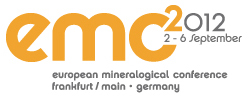|
11b Geobiochemistry and mineralogy of mine waste: perspectives and future goals |
|
Oral Programme
/ Wed, 05 Sep, 11:15–14:15
/ Room H 8
Poster Programme
/ Attendance Wed, 05 Sep, 17:00–18:30
/ Poster Area
|
Since the dawn of civilization, metals and minerals have been mined for the production of goods, energy and buildings. These activities have created great wealth, but they have also produced huge quantities of solid and liquid waste, known collectively as ‘mine wastes’. Even today, tens to hundreds of tonnes of waste are generated for every tonne of ore mined. This raises an interesting debate between extracting mineral resources, essential in the twenty-first century society, and protect the environment, a legacy that we leave future generations on this planet.
The risks relating to mine wastes are directly related to the ways in which their potentially toxic components are released, transported and taken up by flora and fauna. These mechanisms, in turn, depend on the size, character, chemistry and crystallinity of minerals within the mine wastes, and the fluids and organisms they encounter. Mineralogists and geochemists provide important data and insights into all of these factors, which will lead to a better understanding of how to predict, prevent and lessen the impacts of mine wastes on the environment. This session will bring together researchers for presentations on developments in the following areas: (1) characterisation of mine waste minerals and the fluids and bacteria that generate them; (2) short- and long-term stability of minewaste minerals in relation to remediation and control of metal and metalloid release from mine sites; (3) relationships between mineralogy and bioavailability to ecosystems and humans.
Presentations on all advances in the field of environmental studies related to mining areas and their remediation are welcomed.
